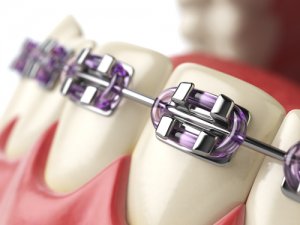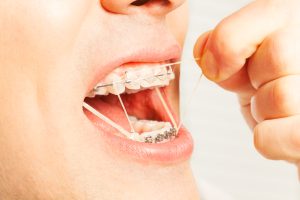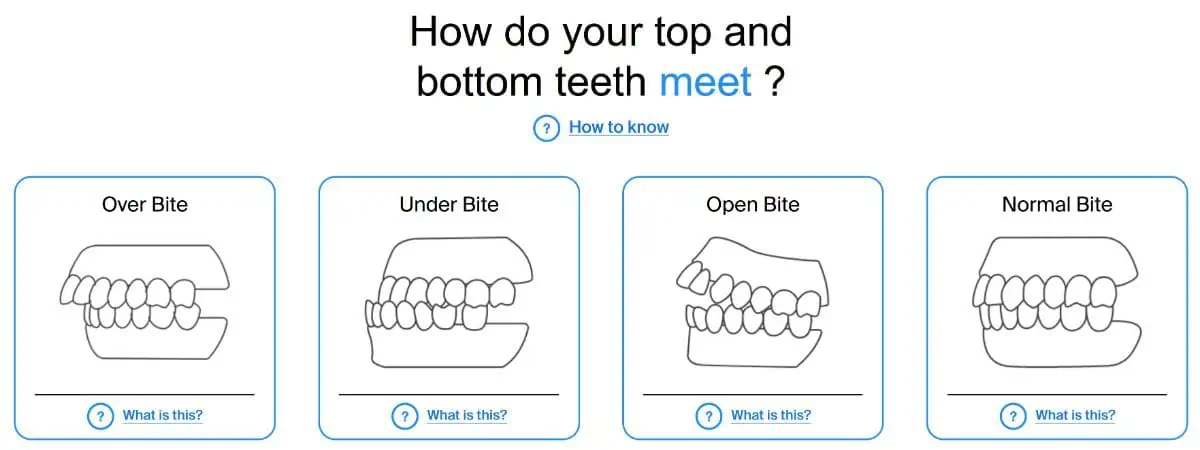If you are getting traditional train tracks you can expect brackets and wires attached to your teeth, but at some point, you will also need elastic bands for braces.
While many people know that you can get colourful braces, they don’t always associate the colours with a type of orthodontic elastic band.
Even fewer people realise that your dentist or orthodontist will use rubber bands to help your fixed dental braces apply more pressure to your teeth and bite to align your smile.
So, if you’re getting elastic bands for braces, or you already have them and want to know more, this article will answer the following questions.
- What are elastic bands for braces?
- Are there different types of rubber bands for braces?
- How do they work, and what do they do?
- When do you start wearing rubber bands for braces?
- How do you put them on?
- Why do rubber bands on braces hurt so much?
Before we jump to what these orthodontic elastic bands are, let’s get started with how braces work and where rubber bands fit into the equation.
In This Article
How do braces work?

Traditional fixed braces are the most common orthodontic treatment and can treat orthodontic issues from mild to extreme. They consist of a system of brackets that firmly attach to your teeth and are joined by archwires.
Your orthodontist adjusts the wires that join the brackets together to apply pressure and move your teeth. Every couple of weeks you will have braces appointments where the wires are re-adjusted to maintain pressure on your teeth and continue your treatment.
Sometimes small rubber bands are used to keep your braces in place, these are called ‘o’ ties or ligatures. They can come in different colours and help to jazz up the look of your braces.
However, the main rubber bands we discuss in this article are bigger and are added to your orthodontic treatment to help straighten your teeth and align your bite.
What are elastic bands for braces?
Orthodontic elastic bands are special rubber bands that your orthodontist attaches to small hooks on both your upper and lower braces.

The placement of the bands will depend on where the pressure needs to be placed to help align your teeth. They can go diagonally or vertically to apply force in areas where your braces can’t by themselves.
Brace elastics look very similar to the rubber bands that you can buy from any stationery store or post office, but they are not the same. Orthodontic bands are designed specially to apply the right amount of pressure to your teeth. So you shouldn’t just use any elastic bands as they won’t work as efficiently or at all.
They typically consist of latex, but there are bands available that are latex-free for those that may have an allergy to latex. Bands can be made from either synthetic material or latex, but this study shows that latex bands last much longer and are more stable over a 24 hour period.
Are there different types of rubber bands for braces?
There are two main different types of orthodontic elastic bands, ligatures and rubber bands. Ligatures are small bands that go around your braces brackets to keep your archwires securely attached. Some types of braces, such as self-ligating braces don’t need these ‘o’ ties to stay in place.
Rubber bands on the other hand are larger and apply pressure in places to aid your braces in aligning your teeth. Braces bands can also be categorised by the amount of force they exert, these categories include:
- Light
- Medium
- Heavy
They come in different sizes depending on where they are to be placed in the mouth and where they are attached.
A braces power chain is a type of orthodontic elastic that helps add tension and pressure to close gaps between teeth. They look like small chains made from elastic bands and they fit over the teeth similarly to how ‘o’ ties do.
How do they work, and what do they do?
Braces bands work by attaching between two points on your upper and lower braces to apply pressure where your braces can’t, such as moving your jaw forwards or backwards to align your bite or to adjust the spacing or positioning of your teeth.
Some of the issues that elastic bands can help your braces treat include:
- Overbite
- Underbite
- Open bite
- Crossbite
Elastic bands on braces have the added benefit of being able to speed up the alignment treatment time, which means less time wearing braces!
The table below summarises the different types of teeth bands, what they are used for and how they work:
Type of orthodontic elastics | Used for | Placement | Treatment action |
Class I Elastics | Closing the gaps between teeth (diastema) | The bands run from the upper first or second molar to the upper canine | Push teeth together to close gaps between the teeth |
Class II Elastics | Correcting an overbite | The bands run from the upper canine tooth to the lower molar | The upper teeth are retracted and the lower teeth are advanced |
Class III Elastics | Correcting an underbite | The bands run from the lower canine to the upper last tooth with a bracket | The lower teeth are retracted and the upper teeth are advanced |
The following video shows how Class III braces elastics can treat an underbite :
When do you start wearing rubber bands for braces?
Your orthodontist won’t recommend that you start using rubber bands until you are about four to six months into your treatment. Sometimes you might start them as late as 12 months into wearing your braces.
This may be because you need to adjust to your braces before adding elastic bands, or it may be that you need to let your braces do their thing before adding to the treatment.

How do you put them on?
When you start wearing your brace bands you should wear them for a minimum of 10 – 12 hours per day. Some patients will need to wear theirs for up to 24 hours per day and only remove them for eating and cleaning their teeth and braces.
You should change the bands for fresh ones each time you remove them. This is to ensure that they keep adding the same amount of force to your teeth as they can weaken over time.
Your dentist will show you how to put them in and take them out, but some tips and tricks include:
- Bite down on your teeth when your place the bands so you have less distance to stretch the band
- Using your fingers to place the bands seems to be the simplest and easiest method
- Hook the band to the top teeth first then stretch the band down to the lower teeth hook
- Use the mirror to help you see where to place the bands
- You can also use a special plastic tool to help you if you can’t adequately pinch the rubber band with your fingertips
- Don’t double up on rubber bands, it won’t speed up the process and can damage your tooth roots
The following video from YouTube vlogger Emma Louise explains all about braces elastics including how to put them in and other tips and tricks:
Conclusion
Braces bands aren’t just the small colourful ‘o’ ties you see people using to jazz up their braces. Although they still have the very important job of keeping the archwires attached to your braces brackets, they don’t apply pressure to move your teeth.
That’s the job of orthodontic elastic bands that attach to hooks on braces. They can help to treat a few different orthodontic issues including malocclusions and diastema (gaps between teeth).
Usually, you won’t need to start wearing braces elastics until you are a minimum of four months into your treatment. However, when you do start to wear them you will need to have them on for anywhere from 10-24 hours per day.
Each time you take them out to eat or clean your braces and teeth you will need to put on fresh elastics. So it’s worth keeping a bag of elastics on you at all times so you can replace them when you need to remove them. Replacing your braces bands often can ensure that you maintain tension and pressure on your teeth.
FAQS
Why do rubber bands on braces hurt so much?
Having bands on braces can cause pain and discomfort because they add extra pressure to your teeth and jaw. You can help to alleviate pain with over-the-counter medication and orthodontic wax.
Are rubber bands the last step to braces?
Orthodontic bands can be the final stage to wearing braces if all other orthodontic issues have been corrected. However, this can depend on the patient’s individual case.
How fast do rubber bands move teeth?
The amount of time orthodontic elastic bands takes to work generally ranges from six to eight months. However, it depends on your individual case and the teeth being moved as every situation is different.
Can you eat with rubber bands on your braces?
While it may be possible to eat with your rubber bands in place, it is recommended that you don’t. Instead, take them out, eat, clean your teeth and replace your braces bands with fresh ones.
How long do you wear rubber bands for braces?
The average amount of time that people need to wear braces elastics is six to eight months for 24 hours a day. However, every orthodontic case is different and your orthodontist may advise differently.
NCBI. Force decay evaluation of latex and non-latex orthodontic intraoral elastics: in vivo study. Consulted 3rd March 2022.




